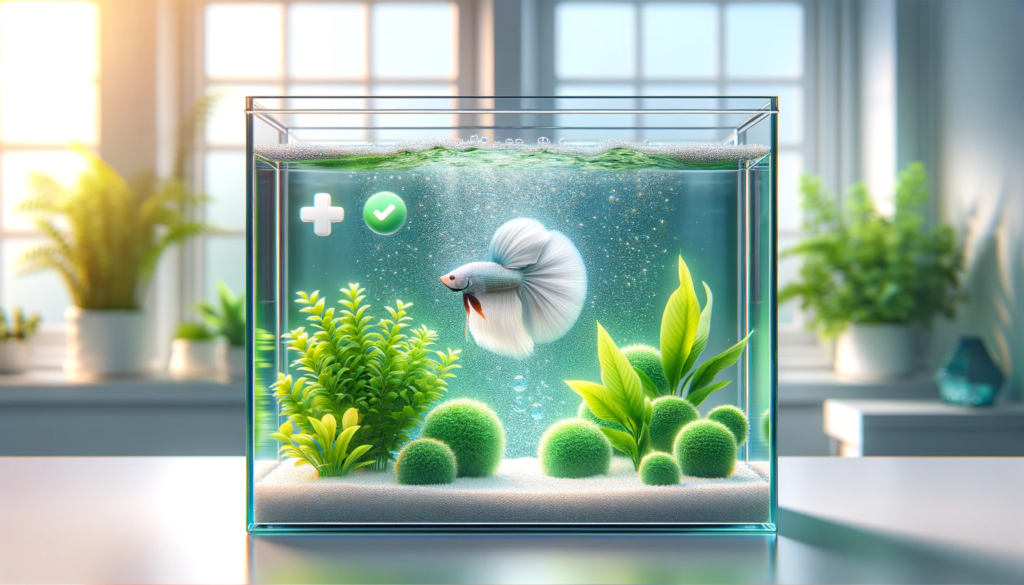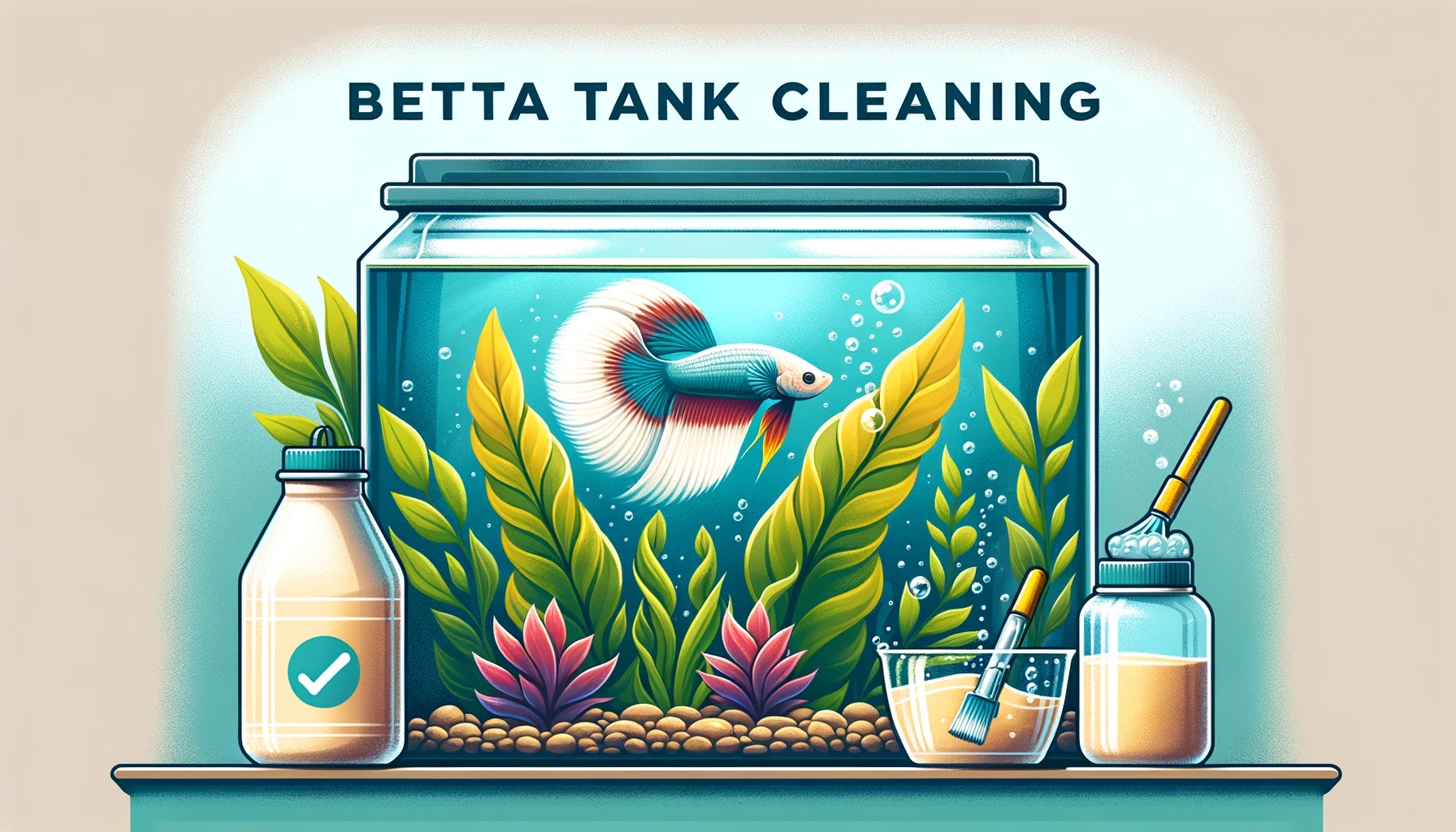Betta fish, with their striking colors and captivating personalities, make for delightful companions in any home aquarium. While they are relatively low-maintenance compared to other pets, the key to their well-being lies in the cleanliness of the aquarium.
Regular tank cleaning is not just about keeping the water clear and free of debris; it’s about creating a healthy ecosystem where your Betta can thrive. Accumulated waste and algae, if left unchecked, can compromise the water quality, leading to potential health issues for your Betta.
This article is your comprehensive guide to maintaining a clean Betta tank, detailing effective cleaning methods and tips to prevent buildup of waste and algae. Here, you’ll learn not only how to keep your tank looking pristine but also how to ensure a safe and healthy habitat for your cherished aquatic friend.
Key Takeaways
- Regular cleaning of the betta tank is essential for the health and well-being of the fish.
- Cleaning frequency depends on factors such as the presence of live plants, food portions, and the use of a filter.
- Cleaning methods include removing waste, cleaning substrate, scrubbing the glass, and replacing tank decorations.
- Neglecting tank cleaning can lead to stressed fish, infections, poor water quality, and even fish death.
Betta tank cleaning method
To clean a betta fish tank, follow these steps:
- Prepare the water for a water change: If you’re planning to do a large water change, make sure to prepare the new water in advance. Treat it with a water conditioner to remove any chlorine or harmful chemicals and ensure it’s at the right temperature for your betta.Follow this guide if you are using tap water
- Remove the betta: Use a net or cup to carefully scoop out your betta and place it in a temporary container with some aquarium water. Cover the container to prevent the fish from jumping out.
- Collect the water for replacement: If you’re replacing some of the water after cleaning, collect the appropriate percentage in a clean container. If your betta tank is filtered, you can collect the water from the filtration output nozzle. Dispose of the remaining water.
- Remove ornaments and gravel: Take out any decorations, rocks, or artificial plants from the tank. Scoop out the gravel using a small spade or your hands and place it in a bucket.
- Clean the tank: Wash and scrub the tank with tap water. Avoid using cleaning cloths or towels that may contain harmful chemicals. Use an aquarium scrub or natural sea sponge to clean the tank thoroughly. Spray the sides with a small hose or tap tail to remove any debris.
- Clean the gravel and ornaments: Wash and sieve the gravel under tap water until all debris and waste are removed. Scrub the ornaments and artificial plants to remove any dirt. Here is your guide to clean decorations
- Put everything back: Place the clean gravel back into the tank and replace the ornaments and plants. Start adding the water by first adding the percentage of aquarium water you collected earlier and then adding the freshly prepared water. Let the system filter for about 10 minutes and check the temperature.
- Add the betta back: If everything is in order, carefully place your betta back into the tank. If the filter cartridge needs to be changed, do it at this time.
How long to wait to put betta fish in tank after cleaning
After cleaning a betta fish tank, it is recommended to wait at least 24 to 48 hours before putting the betta fish back into the tank. This waiting period allows the water to stabilize and the temperature to adjust, ensuring a safe and comfortable environment for the betta fish.
Additionally, it is important to use a water conditioner to remove any chlorine or harmful chemicals from the water before reintroducing the fish. You can put the fish back to tank in an hour.
Remember, this method is for a thorough cleaning and should not be done every time. It’s important to keep some of the original aquarium water to preserve beneficial bacteria. Additionally, if your filter media is not replaceable, make sure it stays submerged in aquarium water during the cleaning process to prevent it from drying out.
Easy Betta Tank Maintenance

Changing the betta tank water regularyl, 20-30%, will help the cleanliness of the aquarium.
Another beneficial tip is to introduce algae eaters into the tank. Algae eaters, such as snails or certain species of fish, can help control algae growth and keep the tank cleaner for longer periods. These organisms feed on the algae, reducing the need for manual cleaning.
What happens to your betta in dirty tank?

Neglecting to clean the betta tank regularly can have serious consequences for the health and well-being of the fish. The effects on fish health and the importance of maintaining water quality cannot be overstated. Here are five key consequences of not cleaning the tank:
- Stressed fish are more susceptible to infections and diseases.
- Dirty water can lead to infected wounds on the betta
- Lack of dissolved oxygen can cause fish to gasp for air at the surface,resulted from dirts and toxins.
- Poor water quality can eventually lead to fish death.
- Keeping the tank clean is essential for the betta’s health and well-being.
Cleaning Filtered/Unfiltered Betta Tank
First of all the cleaning frequency of the betta tank depends on if the tank has a filter or not. And, cleaning process is different between them. I will explain it below.
One important note is, it is important to unplug all electrical appliances in the aquarium to be unplugged bedore the cleaning.
If the betta tank is with filter, a tank cleaning every 6 yo 8 months will be enough. Especially if the filter is quality enough and fits the size of the tank, full cleaning wont be necessery for a long time.
Planted tanks and a few clean up crew (such as snails or scrimps) will create a perfect selfcleaning ecosystem. In this case, you may not need to clean your betta’s tank oveer a year.
Continious filtrationr helps to remove harmful substances and maintain optimal water conditions for your betta fish. also a filter promotes the growth of beneficial bacteria, which play a crucial role in breaking down toxic substances such as ammonia and nitrites.This is why dont keep your betta without filters.
However, if the tank is not filtered, you would need to clean a 5 galloon (19 lt) betta tank in every 4 to 5 weeks. Fish poop will accumulate faster then normal.
By continuously circulating and filtering the water, a filter helps to remove harmful substances and maintain optimal water conditions for your betta fish. Additionally, a filter promotes the growth of beneficial bacteria, which play a crucial role in breaking down toxic substances such as ammonia and nitrites. This not only helps to keep the water clean, but also provides a more stable and suitable environment for your betta fish.
- Perform partial water changes regularly to remove accumulated waste and debris.
- Use a siphon or turkey baster to clean the substrate by removing any uneaten food or waste.
- Scrub the tank glass and corners with a soft brush or sponge and warm water to eliminate algae and dirt.
- Replace tank decorations and accessories after cleaning to prevent the buildup of bacteria and waste.
- Maintain the balance of beneficial bacteria by pouring in a mixture of old and new water during water changes.
In any case, as I mentioned above, if the betta aquarium has no filter, tank cleaning should be more frequnt than a filtered one.
Tank Size Considerations
When considering the cleanliness and well-being of a betta tank, it is important to take into account the size and the shape of the tank. Tank size plays a crucial role in cleaning efficiency and proper tank setup.
A larger tank provides more space for the fish to swim and reduces the concentration of waste. With a larger tank, it is easier to maintain water quality and keep the tank clean.
On the other hand, smaller tanks require more frequent cleaning due to the limited space and higher waste concentration. It is recommended to provide bettas with at least a three-gallon tank to ensure optimal cleaning efficiency and a healthier environment for the fish.
Proper tank setup, including the appropriate tank size, is essential for the overall well-being of bettas.
In conclusion, neglecting the cleanliness of a betta tank can have dire consequences for the health and well-being of these delicate fish. Dirty water can lead to stress, infections, and even death.
However, by implementing proper cleaning methods and utilizing essential tools, betta owners can maintain a safe and comfortable habitat for their fish.
Remember, a clean tank is not just a matter of aesthetics, but a crucial factor in ensuring the longevity and happiness of your betta.
Don’t let neglect be the silent killer of your beloved fish.

